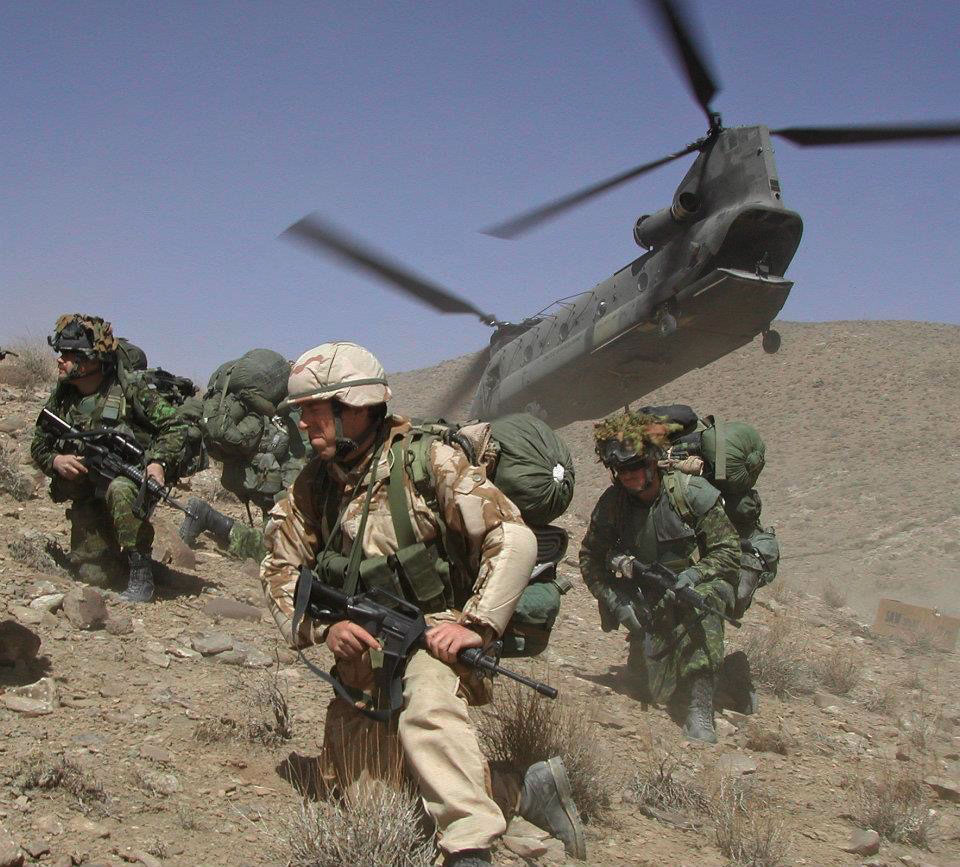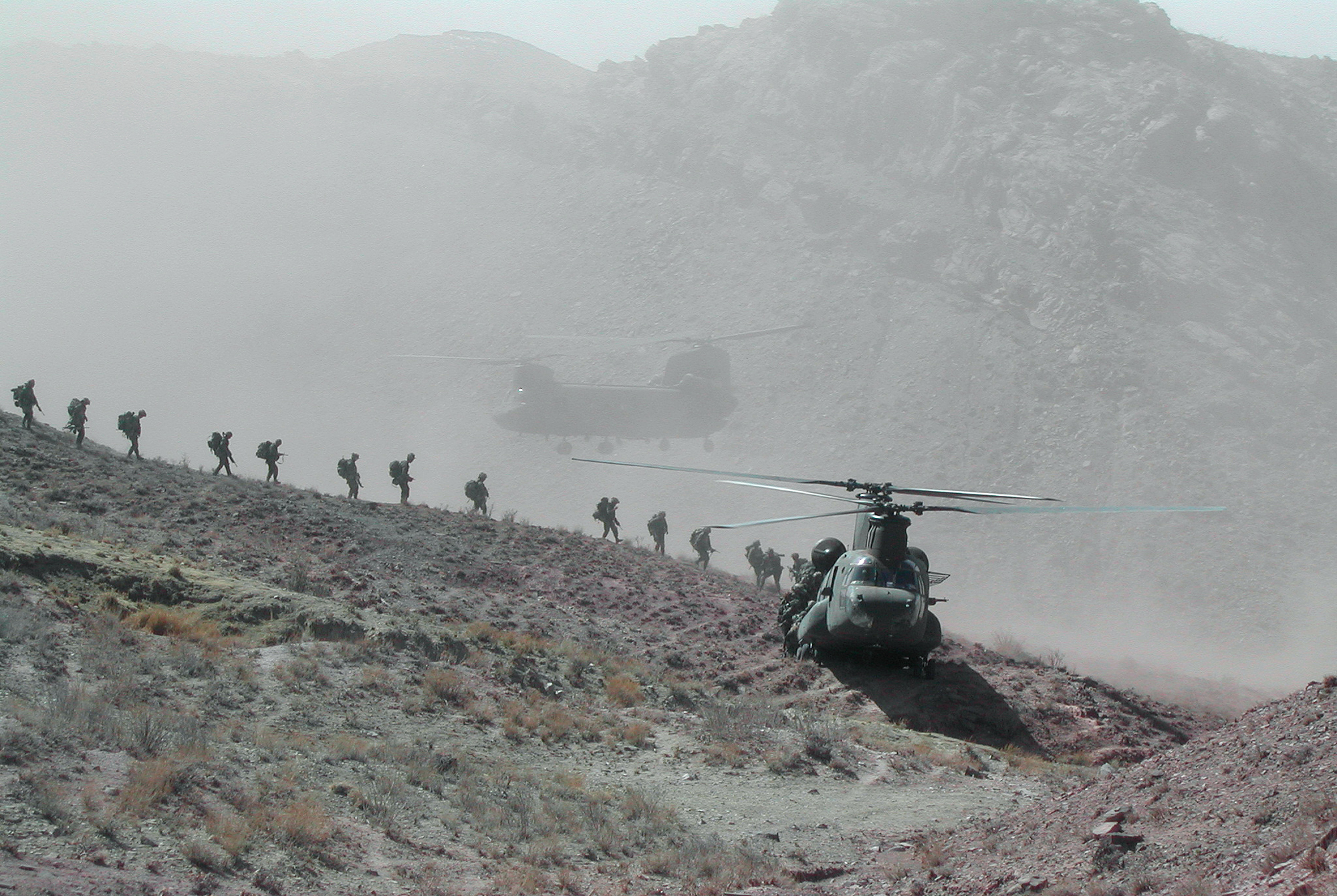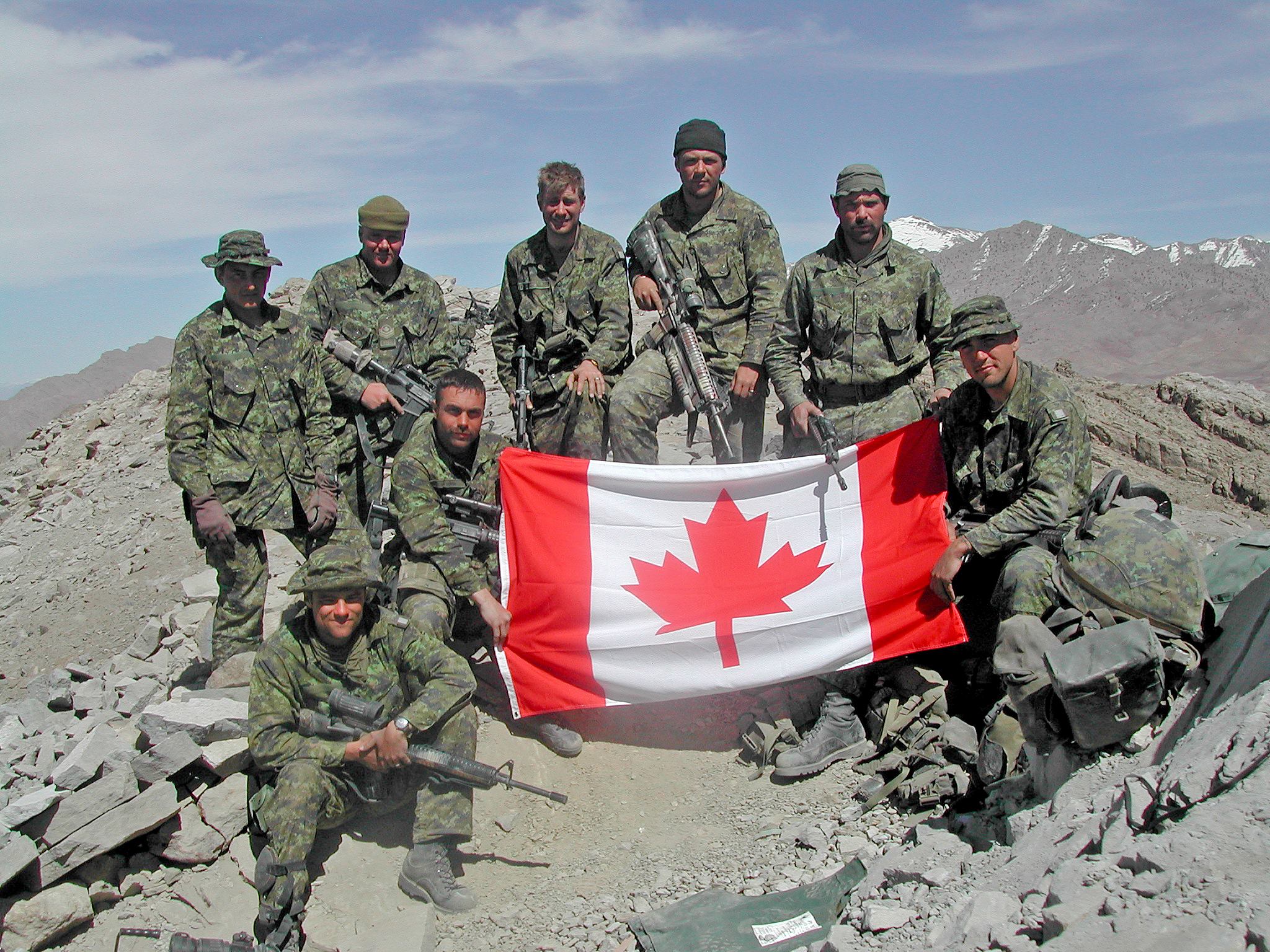
Wednesday, March 13, 2002, broke sunny and cool as 500 Canadian soldiers assembled on the tarmac in the yellow morning light at the U.S. military base in Bagram, Afghanistan.
Wearing their new green camouflage fatigues on combat operations for the first time, they sat and stood in groups of 30 to 40 soldiers, preparing to board the U.S. Chinook helicopters that would take them on Canada’s first-ever helicopter-borne assault.
It would also be Canada’s first wartime assault since the Korean War, nearly 50 years earlier.
Twelve hours ago, platoon leaders had been handed an intelligence report detailing what awaited them at their destination, a mountain called the Whale’s Back. Sixty to 80 al-Qaida fighters from places most of these soldiers would never see—Chechnya, Pakistan and Uzbekistan—were staging their final stand as remnants of Osama bin Laden’s terrorist network escaped Afghanistan through the mountainous foothills to the relative safety of neighboring Pakistan.
They had told villagers they should leave the Shah-i-Kot Valley, where for almost a month they had given troops from the American 101st Airborne Division and two Canadian sniper teams a hell of a fight.
The 500 Canadians headed for the Whale were told they would probably be dropping into a hot landing zone, that they should expect casualties. The intelligence report said these last enemy soldiers were prepared to fight to the death.
There, out on the tarmac among the rows of soldiers putting on camouflage, adjusting equipment and checking weapons, a U.S. Army padre in battle fatigues and a field cap was giving communion to waiting troops.
Amid the throng was an eight-man reconnaissance squad from 3rd Battalion, Princess Patricia’s Canadian Light Infantry, in Edmonton. They were led by the reconnaissance commander, Captain Ryan Latinovich of Welland, Ont., accompanied by his radioman, Master Corporal Erik Kuerr of Edmonton.
Sergeant Torry White was technically the section leader. His unit consisted of MCpl. Chuck Cote of Edmonton; MCpl. Vic Mover of Thunder Bay, Ont.; MCpl. Jeff Whibbs of Peterborough, Ont.; Private Francis McCann of Langley, B.C.; and Pte. Shaun Cameron, from Duck Lake, Sask. As recce, they were to be first in, last out—at the vanguard of what would become a long and bloody mission in Afghanistan. Their faces were calm, resolute, and almost peaceful. This, after all, was what they had trained for their entire careers.
It was a long, low helicopter ride out to the mountain near the town of Gardez. Packed with 40 heavily burdened soldiers and one journalist, the Chinook dodged and weaved among the hills and rocks and across plains and valleys, swirling up dust and sending herds of goats and sheep scattering along the way.
They were aboard the fourth helicopter in, landing halfway up the mountainside in a whirlwind of noise and dust, pouring out of the back of the chopper to form a perimeter.
The closest welcoming committee was friendly: allied Afghans, it appeared, sitting on a nearby peak. They waved and watched for a while, then left.
Afghan militia had moved in while the Canadian operation was being planned, rousting some enemy but at the same time preventing the Americans from dropping three powerful daisy-cutter bombs intended to make way for the Canadian assault.
The Canadian commander, Lieutenant-Colonel Pat Stogran, was not happy. He figured all the Afghans had managed to do was tip off the enemy that something was afoot—unintentionally or, as is often the case in the mixed ethnic allegiances of Afghanistan, otherwise.
The recce group split off from the main force, making their way up the mountainside, straining under 50 kilograms and more of gear.
An officer built like the proverbial fire hydrant, Latinovich was a graduate of the Royal Military College. At 28, he was already a nine-year military veteran. He appeared absolutely confident in his task.
It was hard going. The mountainsides were steep and covered in loose shale. There were remnants of U.S. bombing—craters in the hard rock the size of Jacuzzis or bigger. Unexploded ordnance and ammunition, including the infamous cluster bombs known as BLU-92s, were scattered everywhere.
Bending under the weight of their packs and carrying weapons, helmets and flak jackets, the recce troops proceeded slowly, in single file, carefully placing each step and pointing out each unexploded bomb to the man behind. The thin mountain air robbed lungs of oxygen; the anticipation of what lay around each corner and over each rise quickened heart rates and compounded the effects of altitude and exertion.
They reached the ridgeline at something over 8,000 feet by mid-afternoon. There were still traces of snow on the Whale, known to Afghans as Tergul Ghar. To the north could be seen the hulk of an American Chinook, shot down in fierce fighting the week before.
To the east, across the valley, lay the mountain range where, for the next four days and nights, they would witness the wrath of the mighty B-52s as they dropped their payloads on enemy targets.
As they settled down for the night, fully exposed on the east side of the ridge, they could hear the drone of an unmanned observation plane overhead, the screech of F-16s, and the roar of the B-52s, their contrails cutting huge arcs and figure-8s in the sky. The explosions were spectacular, some as high as mountain peaks rivalling those of the Canadian Rockies.

Elsewhere on the mountain, Canadian engineers were destroying more caves and mortar positions—a total of 45 were found on the five-day operation, 15 more than previously had been known to exist.
White and Mover set out ahead to scout the terrain. Nearing the end of the long mountain, they found a bomb hole and debris, including a tripod mount, an unexploded grenade and belts of ammunition. Around a large rock, they discovered a single gun position—a small dugout with a rock wall. Down to the left was more ammunition, along with three mortars and a recoilless rifle with a round inside. Just behind was a bomb crater about three metres in diameter.
The machine-gun nest looked out across a swale 150 metres to a castle-like rock formation at the southern end of the mountain. On the east side of the feature, looking across the valley to the mountain range, was a stone bunker. It took a trained eye to notice it.
“What keyed me to the fact that it was a good objective was that all the way along the ridgeline, the bunkers had been destroyed,” White said. “This one was intact.”
Latinovich arrived and the two consulted. There was no sign of life around the bunker. It apparently had no view back down the mountain. One of the Canadians set up his machine gun, took out his binoculars and watched.
White radioed in their co-ordinates and a platoon of 10th Mountain boys, who were already collapsing from heat and altitude exhaustion, set out in their direction. Whibbs made the long, hard trek back along the ridge to lead them in.

The American officer listened as Latinovich outlined his proposed scenario. The officer nodded and ordered a dozen of his soldiers to assume positions along a natural rock wall tailing off to the left—a firebase that looked for all the world like a firing line straight out of the American Civil War. An assault force took up positions to the right.
The Americans then launched two anti-tank rockets into the bunker, destroying it and blowing the head off an al-Qaida fighter who was seated eating a bowl of rice. Then they opened up with a deafening volley of machine-gun fire.
A minute or so later, the guns ceased and the assault force poured across the swale and swarmed over the castle rock, firing as they went. Three Canadian snipers were with them, and several of the recce crew fanned out behind them to watch their flanks.
A convoy of what appeared to be allied Afghans was stopped on a road to the west, thousands of feet below, watching the action. Rat-a-tat-a-tat. Boom. Rat-a-tat. Smoke billowed from the cave.
The soldiers were firing down at 45-degree angles or more through so-called wormholes into the darkness of the caves. Reports came back over the radio of two enemy dead; no coalition casualties.
When it was over, the Americans came trudging back. There were no formalities or high-fives. It was as if they had just played a hard-fought game of football and were too exhausted to celebrate.
They disappeared almost as suddenly as they had come, without fanfare. A day’s work in 25 minutes. It was unclear if anyone had fired back through the whole thing—one American soldier said yes, another said no. There were two dead that they knew of, and probably more inside the caves, where the soldiers had seen stacks of rockets and mortars, even IV bags hanging from the ceiling.
The young Canadian rifleman, Francis McCann, looked non-plussed. “I never thought in this day and age it would have to come to this,” he said.
A day later, the 10th Mountain boys were pulled from the Whale. At least a dozen had to be revived with saline IVs and, to Stogran’s disgust, many had shed their equipment all over the mountainside. This, largely because they had just spent a couple of months at sea level in Kuwait, arriving shortly before they were sent to the mountaintop.
Their sloppy exit extended far beyond the Whale into the command-and-control facilities at Bagram, where it wreaked near-disastrous consequences that would later ring with a haunting poignancy.
The U.S. brigade commander who ordered the Americans off the mountain also took his duty officer out of the tactical operations centre—an air-to-ground link located in a hangar at the base northwest of Kabul. In doing so, he did not bother to tell the Canadians their primary link to air forces had been severed.
So when an F-16 picked up activity on the Whale, the pilot thought he had a plumb al-Qaida target in his sights. He relayed the co-ordinates to an American AWACs (airborne warning and control system) aircraft.
When that aircraft passed them on to Bagram seeking clearance to allow the F-16 to drop its bomb, there was nobody in the tactical operations centre officially aware that the Canadians were even on the mountain.
A U.S. air force controller called out the co-ordinates and U.S. army plotters checked their computer screens. Nobody clued in to the fact that the figures the F-16 pilot was seeing were Canadian troops, even though they wore reflective tape on their helmets specifically to prevent attack by friendly aircraft.
A Canadian captain who happened to be in the operations centre at the time heard the co-ordinates, peered over the shoulder of a U.S. army controller and realized he was looking at the Whale.
“Check fire!” he called out. “Those are Canadians out there!”
Soldiers in Bagram at the time estimated the Canadians came within a few seconds of being bombed.
The incident would likely have cost many more lives than the four taken by an F-16 a month later at the Tarnak Puhl training compound near Kandahar. Sheer luck and a large wadi or drainage ditch prevented more deaths at the former al-Qaida site. There was little such protection on the rocky ridgeline of the Whale. Many of the Canadian troops were exposed and vulnerable throughout most of their mission.
Three days after the assault, the Canadians would pull out, ending Operation Harpoon. There would be many more operations to come over 12 more years in Afghanistan; 158 Canadian soldiers would die; thousands more would suffer physical and psychological wounds.
Advertisement
















